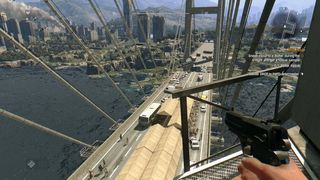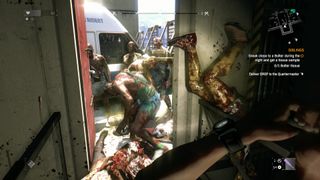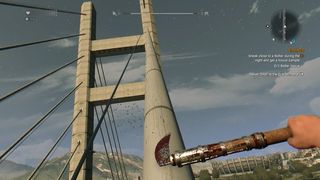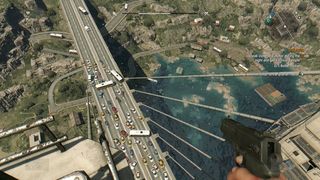How a bridge full of zombies reminded me of the great possibility of games
My favourite thing in Dying Light isn’t the freerunning, or the day/night cycle, or the customisable weapons that I nevertheless do enjoy crafting in order to pulverise the at-one-remove-from-humanity-so-this-bloodlust-is-fine population of Harran. My favourite thing is an actual thing - a place, a small playground of concrete and cables that I enjoy more than anything else in the game. My favourite thing is a bridge.
It’s not even a good bridge. I mean, it’s broken, so technically it’s not a bridge at all, more a couple of platforms above a body of water, like a really ugly pier filled with your reanimated neighbours instead of arcades and a chip shop. But it has a certain something.

When I found the bridge I immediately wanted to kill all of the zombies on it and then - I’m not really sure - maybe have a party and invite all the people I knew in Harran who weren’t dead, or undead, or undead and then killed by me on the bridge. There was something innately attractive about it, is what I’m trying to say, an unusually dense crop of zombies, packed between abandoned cars and buses right up to the exposed and ragged edge of the bridge, its newly frayed rebar bordering with thin air.
Tossing zombies off this border was one of the things that kept me coming back. Well, every new murder trick I learned as I levelled up my grim parkour hero, saving the city one fashionably mounted fence at a time, was a reason to come back. Sending them flying like skittles with my shoulder charge. Dropkicking them into the river. Tossing flammable liquid over them and watching them twist and burn into satisfying smouldering piles, which made me feel a bit like I’d been camping.
Soon, though, all the ways of murdering the zombies gave way to curiosity and boredom, and when that happened I jumped off the bridge and into the water. Partly to see if I would die, because when a man is tired of dropkicking corpses into the sky he is tired of life, but also because there was another section of bridge visible in the middle distance. An isolated T of road standing upright in the river. I wondered if I could swim to the root of the supports. I wondered generally about possibilities, and the unknown.

I did not die. So much so that I was able to swim to the base of the next section of bridge, where I found a small platform I could climb onto. From here, a doorway into the hollow interior of the support. A way up! Also, a way of falling down. My parkour skills were put to the test inside this concrete tower, where an unconventional design had seen a ladder eschewed in favour of a series of hazardously navigable ledges and platforms.
This was the beginning of my love affair with the geography of the bridge. I didn’t write it any letters, but we spent many sunsets together, which often led to me being brutally murdered when the sun finished setting and marauding superzombies arrived. I loved how my exploration was rewarded, how my intuitive hope had been anticipated and turned into interactive space, and that there were layers to this place worth uncovering. I loved the stark angles of the architecture, the pleasure and freedom of clambering across it. And I loved that it nothing to do with what I was supposed to be doing.
Sign up to the 12DOVE Newsletter
Weekly digests, tales from the communities you love, and more
In the end my obsession with the bridge climaxed when I decided I would climb one of the many support cables running from road level up to the outside of the towering concrete supports. Unlike the deadly inconvenience of the tower interior, it wasn’t obvious whether or not these cables could be climbed, or what I might expect to find at the top. It felt like I might be creeping up on the game, tiptoeing into its blindspot with every inch I shuffled up the thick metal rope. I fell off enough times to make more sensible men, with a story to follow and a map full of objective markers, give up and relax into their role as the nimble saviour of mankind. But I kept going, kept flicking the analogue stick on my controller, cursing the wind, and getting closer to whatever it was I hoped to find.

What did I actually find when I finally reached the top, hours later? A beautiful view. A new weapon to temporarily stymie the blandness of killing. And a strange feeling of positivity and vindication. Man, I love that bridge. Maybe I really would go camping there.
Why did all this happen? Why did I become obsessed with climbing a metal cable on a broken bridge in an unreal world that was busy giving me other jobs? I have scientifically divided the answer into two reasons.
The first one is because I wasn’t sure if I could.
Games now have a firmly established grammar of interactivity. We might grumble about the inelegancies of this system every so often - invisible walls, or uppity doors that don’t even respond to an action button prompt, as if the entire purpose of doors wasn’t to open, or at a push not open, but either way to contend with the issue of openability. But we generally understand at a glance what we will and won’t be able to interfere with in a given virtual space. There now exists a rule-of-thumb standard among top-line console and PC games, a sort of minimum spec for making a world that isn’t a disappointing cluster of unanswered geometric invitations, a wendy house with guns and a disproportionate number of urban athletes. There is an unwritten contract here. We know, by and large, which buildings we can enter, which vehicles are ‘live’, which paths meander to a more or less artfully disguised nowhere.

In other, shorter words, there are few surprises any more. And there, at the unseen summit of the bridge, was the possibility of one.
The other reason is perversity, which takes things a step further than “Because I wasn’t sure if I could” and casts a suggestive glance at “Because I’m not supposed to.” This is the willful subversion of the task at hand, and the urge to find something better.
This kind of civil disobedience in games has an established history. Tony Coles once wrote a wonderful thing for Edge insisting he would never finish Fallout: New Vegas because he had discovered a more compelling story than the one the game was offering him, in which he remained a humble vigilante of the new frontier. “Whatever your moral alignment, the wasteland is full of threats preying on the weak and the innocent, and a lone, stoic hunter is what’s required to make the world safe.” Similarly, PC Gamer’s Andy Kelly made an unexpectedly dramatic video series about Olaf, an honest man looking to make a fortune with an honest day’s work in the world of Skyrim, which intentionally sidestepped the majority of the game’s systems and anticipated user journeys.

This urge, to find enjoyable things to do within a world not specifically built for that purpose, is probably related to the ridiculous magnetism of glitches. Both stress-test created worlds, to see where their boundaries lie. Unlike glitches - which just remind me that somewhere there is a person who probably worked very hard on something they cared about and never got it quite right - finding a successful way to ‘unplay’ a game both strengthens and weakens that world. The world itself is proved robust enough to handle the unorthodoxy and therefore becomes more solid and real, but at the same time we are stepping outside of its functional authority.
And stepping outside of authority is, of course, a good description of play. And actually now I consider it (which I arguably should have done earlier, perhaps while I was thinking about camping) this is the heart of everything. This is why the bridge drew me in, and why the possibilities of that bridge felt so electric - because feeling out these worlds and trying to subvert them is perhaps a purer form of play than actually playing them. Play is after all a negotiation of and challenge to authority. Games need rules, and play defines itself against order. Exploring a thin crack of possibility running through an otherwise stable and regulated system - that is the kind of beautiful, rare offering that makes games so special, and makes trying to climb a cable to the sky worthwhile.












